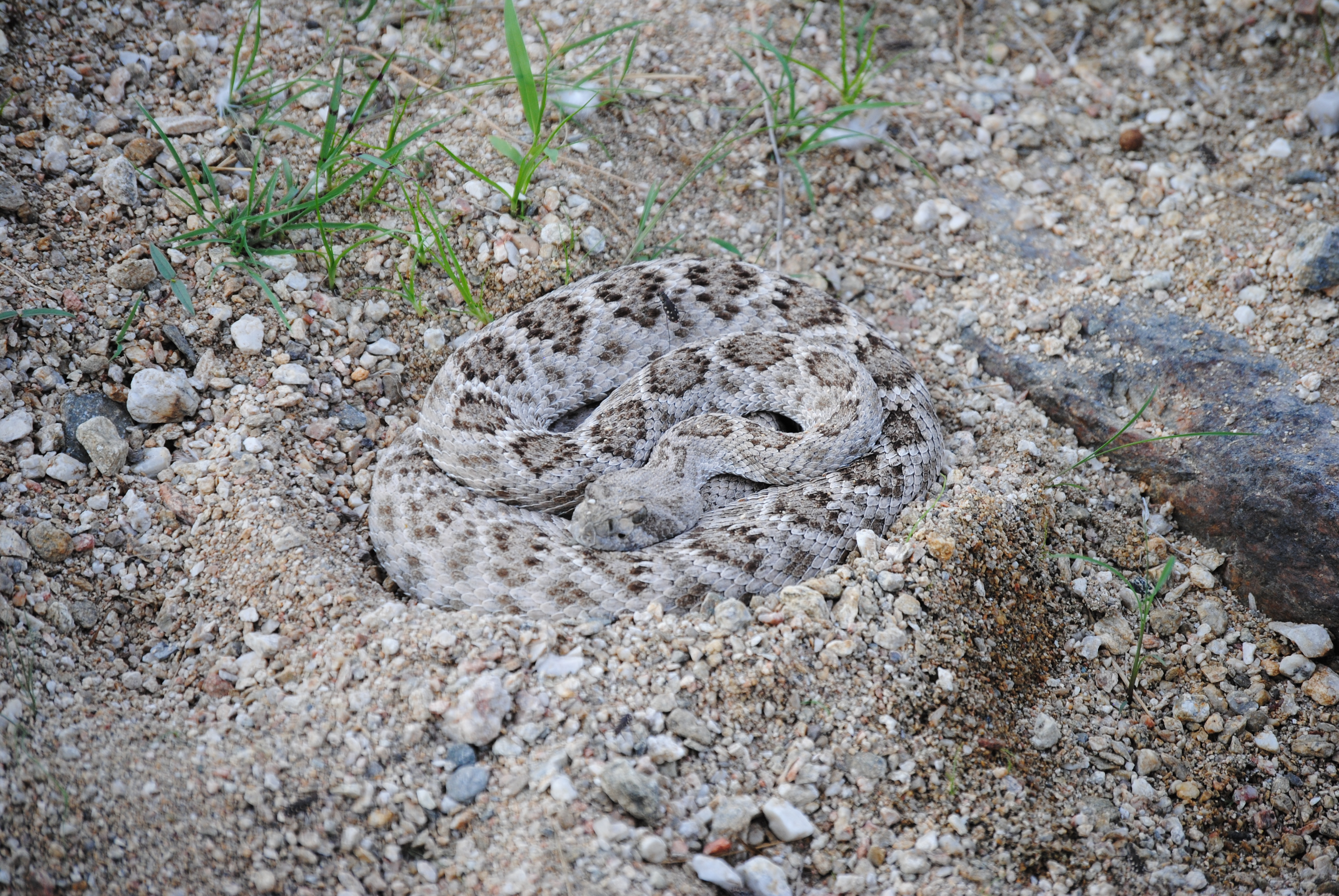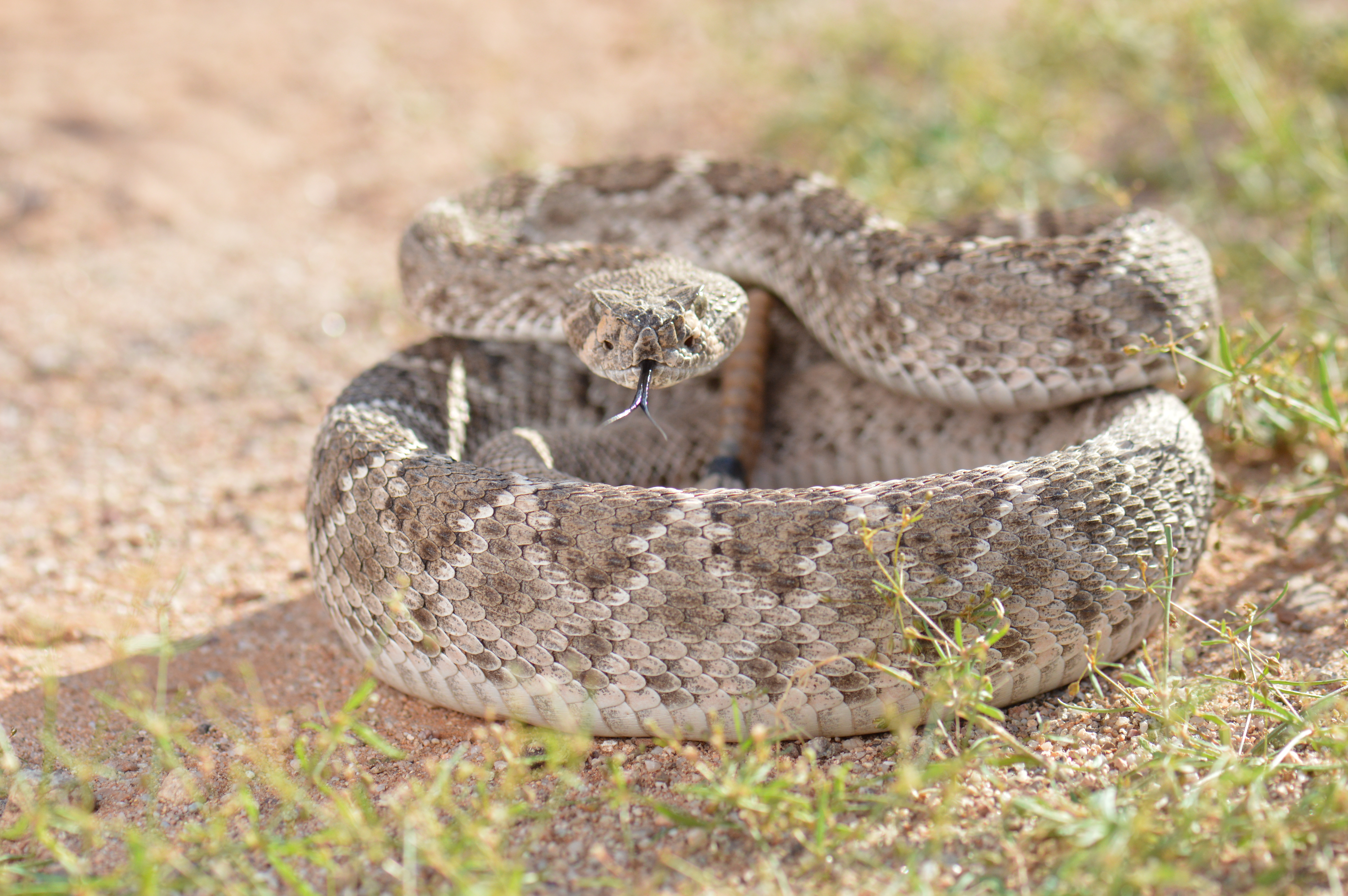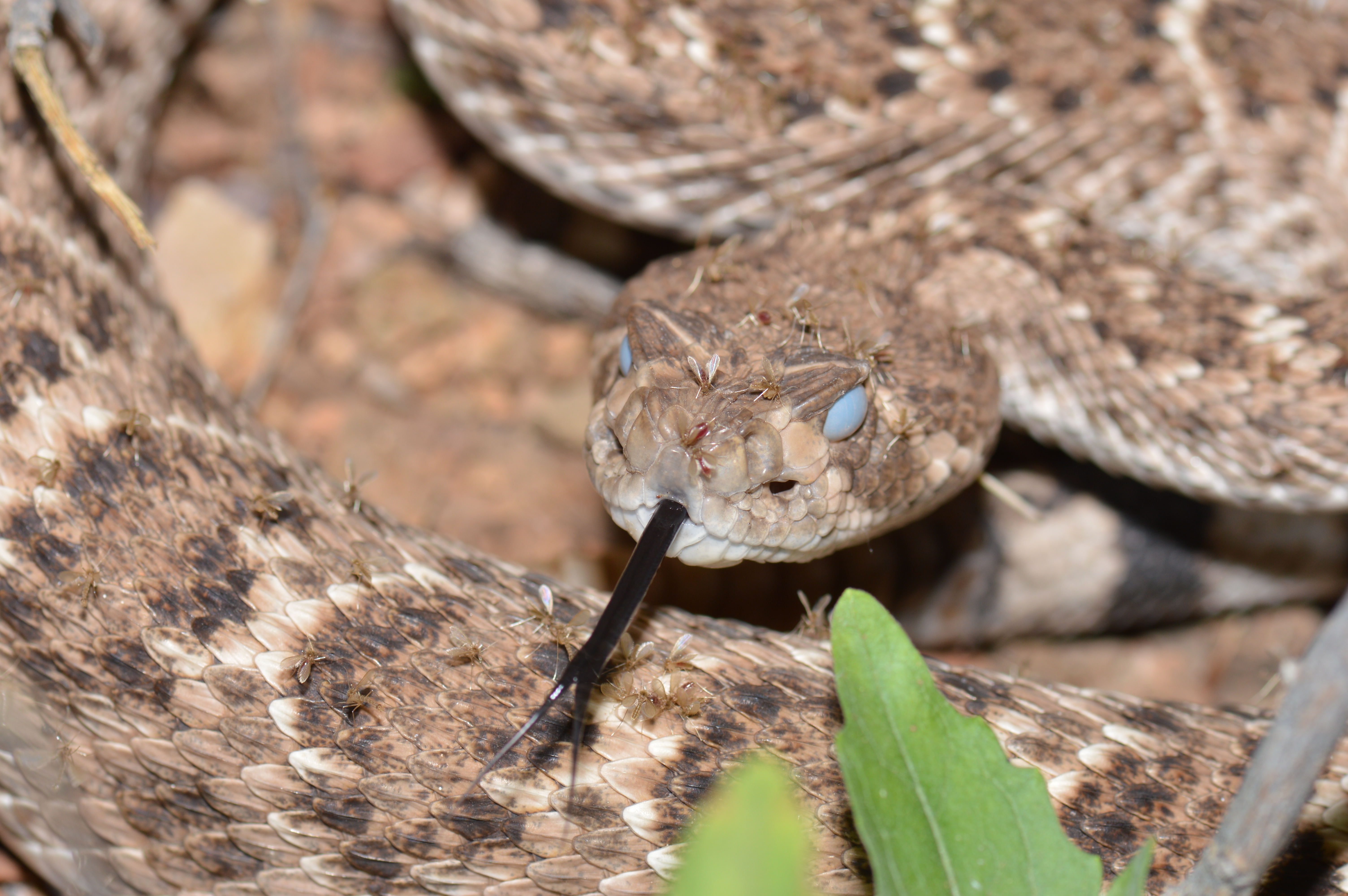Western diamondback rattlesnake (Crotals atrox)

The Western Diamondback Rattlesnake (Crotalus atrox) is an iconic species inhabiting the arid regions of North America, particularly prevalent in the southwestern United States and northern Mexico. Renowned for its distinctive diamond-shaped markings along its back and its menacing rattle at the end of its tail, this formidable pit viper commands respect in its ecosystem. With a potent venom designed for subduing prey, including small mammals and birds, the Western Diamondback plays a vital role in maintaining ecological balance. Its adaptation to diverse habitats, ranging from deserts to grasslands, underscores its resilience and significance in the intricate web of desert ecosystems.
The Western Diamondback Rattlesnake is Arizona's largest rattlesnake and boasts an impressive length, often reaching up to 66 inches (>1600 mm) and occasionally up to 90 inches, excluding its rattle. Its coloration varies from gray to tan, occasionally displaying hues of pink, rust, or orange towards the posterior part of its body. Dorsally, it features a striking row of large, diamond-shaped blotches, ranging from brown to sandy-brown, with distinct dark edges and often outlined in cream or pale gray. These blotches are peppered with dark speckles, lending the snake a speckled or dusty appearance. Its tail is adorned with alternating black and white bands of roughly equal width (though that can vary significantly with some individuals having thicker black or light colored bands), reminiscent of a "coontail." A thin, light-colored stripe extends from the posterior corner of the eye down to the upper lip. Notably, the Western Diamondback Rattlesnake possesses a broad, triangular head and a slender neck, with keeled dorsal scales and vertically elliptical pupils.
In the United States, it inhabits central and western Arkansas, Oklahoma (excluding the northeast, north-central region, and the panhandle), Texas (excluding the northern panhandle and the east), southern and central New Mexico, Arizona, extreme southern Nevada, and southwestern Utah. In Arizona, the Western Diamondback Rattlesnake is prevalent throughout the southern and most of the western regions, thriving across diverse elevations from near sea level along the Colorado River to approximately 5,300 feet in southeastern and sub-Mogollon Rim central Arizona. Overall, its range spans from sea level to around 8,200 feet in elevation.
The Western Diamondback Rattlesnake occupies an array of habitats within arid and semi-arid regions, spanning from plains to mountainous terrain. Within these regions, it thrives in communities like Sonoran, Chihuahuan, and Mohave desertscrubs, Semidesert Grassland, and the lower reaches of Interior Chaparral and Madrean Evergreen Woodland. The snake tends to be most abundant above flats on bajadas, hillsides, and slopes, making effective use of the varied terrain. Its habitat extends from flat coastal plains to steep rocky canyons and hillsides, exhibiting associations with a broad spectrum of vegetation types, including desert expanses, sandy creosote areas, mesquite grasslands, desert scrub, and pine-oak forests.

The Western Diamondback Rattlesnake is a skilled predator, employing an ambush hunting strategy by coiling along rodent trails and patiently waiting for prey to venture within striking distance. Its diet encompasses a variety of prey, including mammals such as rabbits, squirrels, mice, and rats, along with lizards, birds, and occasionally amphibians. This snake utilizes its venom, injected through long, hollow, retractable fangs, to swiftly incapacitate and begin digesting its prey. After striking and envenomating its target, it releases the prey and follows its scent trail to secure the meal, minimizing the risk of being bitten or clawed by the prey. When encountering birds, they may be held in the snake's mouth upon striking, as they could otherwise escape before succumbing to the venom.
Young individuals may supplement their diet with insects like cicadas or locusts.
This species exhibits a versatile hunting behavior, active both during the day and night, primarily diurnal and crepuscular in cooler seasons, and primarily nocturnal and crepuscular during hot summer months.

Apart from being a predator, the Western Diamondback Rattlesnake also plays a role in the ecosystem as prey for larger mammals and birds such as coyotes, foxes, hawks, and owls. Despite its hunting prowess, it can go for extended periods without food, with some individuals surviving up to two years without a meal. During periods of starvation, they conserve energy by reducing their expenditures, relying on energy-rich lipid stores to sustain them. Notably, they are among the few snake species known to engage in scavenging behavior, further highlighting their adaptability and resourcefulness in securing sustenance.
Reproduction in the Western Diamondback Rattlesnake occurs semiannually, once during the spring (March – April/May) and the late summer months (August – October). This species is viviparous, giving birth to live young rather than laying eggs. Gestation typically lasts around five to seven months, with females birthing broods averaging about a dozen offspring, thought the evidence suggests broods may be larger in wetter regions and smaller in more arid regions. However, mortality rates among the young are high, as they only remain with the mother for a short period of time before venturing out on their own to hunt and seek shelter. These newborns, measuring up to 30 cm (12 inches) in length, are fully capable of delivering venomous bites from the moment they are born, underscoring the survival challenges they face from the outset.
The venom of the Western Diamondback Rattlesnake, like that of other American pit vipers, is characterized by its proteolytic enzymes, which are concentrated secretions aimed at breaking down structural tissues and proteins. This venom primarily exhibits hemotoxic properties, targeting blood vessels, blood cells, and the heart. Its composition includes zinc metalloproteinases, contributing to hemorrhagic effects, alongside cytotoxins and myotoxins that inflict damage on cells and muscles, exacerbating cardiovascular impairment. Metalloproteinases induce myonecrosis, resulting from ischemia secondary to bleeding and reduced tissue perfusion, while also impeding skeletal muscle regeneration, leading to fibrosis and permanent tissue loss. Local effects encompass pain, extensive internal bleeding, severe swelling, muscle damage, bruising, blistering, and necrosis, with systemic symptoms varying and nonspecific, potentially including headache, nausea, vomiting, abdominal pain, diarrhea, dizziness, and convulsions. Hemorrhagic bleeding, a significant clinical outcome, can be fatal. Despite having LD50 values indicating lower toxicity compared to many other rattlesnakes, the Western Diamondback Rattlesnake's large venom glands and specialized fangs enable the delivery of substantial venom doses in a single bite. On average, venom yield ranges from 250 to 350 mg per bite, with some cases reaching 700–800 mg. While severe envenomation is infrequent, it can be deadly, with untreated bites carrying a mortality rate of 10 to 20%.
To distinguish the Western Diamondback Rattlesnake from similar species in Arizona, consider key features unique to this snake. The Mojave Rattlesnake can be differentiated by its enlarged scales between the supraocular scales, narrow black tail rings, and a white stripe behind the eye extending behind the corner of the mouth. Meanwhile, the Speckled Rattlesnake typically displays salt-and-pepper markings, with pre-nasal scales that are usually separated from the rostral scale by small scales and the supraocular scales exhibiting distinctive pitting or a deeply furrowed appearance.
References:
Brennan, T. C. (n.d.-b). Western Diamondback Rattlesnake. The reptiles and amphibians of Arizona. https://reptilesofaz.org/snakes-subpages/h-c-atrox/
McGinnis, S. M., & Stebbins, R. C. (2018). Peterson Field Guide to Western Reptiles and Amphibians. Houghton Mifflin Harcourt.
Brennan, T. C. (n.d.-b). Western Diamondback Rattlesnake. The reptiles and amphibians of Arizona. https://reptilesofaz.org/snakes-subpages/h-c-atrox/
Repp, R. A., & Schuett, G. W. (n.d.). Western Diamond-backed Rattlesnake. Tucsonherpsociety.org. https://tucsonherpsociety.org/amphibians-reptiles/snakes/western-diamond-backed-rattlesnake/



